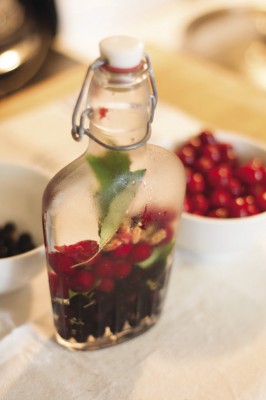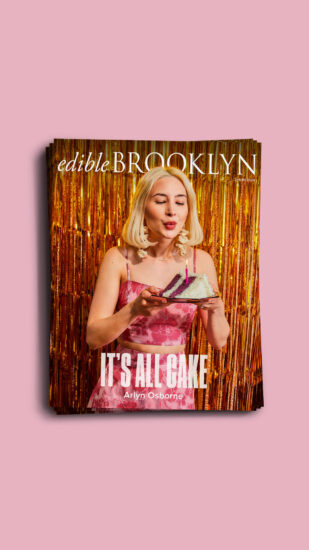In our apartment a wintery foraging feast kicks off with the shimmering sound of a cocktail shaker. In it are a pouring of botanical infusions—a rapidly integrating suspension of red currant gin and sumac vodka, both already well sampled and loved by now—as well as the first unstoppering of my first batch of Brooklyn bitters.
The moment is a little tense. I began these bitters in summer, when Brooklyn was still fully leafed.
Remember leaves?
In late winter the stippled yellow silhouettes of Cornelian break bud before any other tree. By late summer their small, plum-like fruits hang like drop earrings beneath the leaves. Amber, turning crimson and at last a juicy garnet. Unpicked, they drop to ground, creating that thing that civic-minded Americans hate so much: mess.
They are not really cherries at all, but the fruit of an imported dogwood most at home in Eastern Europe, where they have been enjoyed for thousands of years.
Over the July sidewalk of Congress Street, just east of Clinton, green branches bend. Beneath them I reach up and pick the red fruit from the lower branches.
A father and his strollered son stop and the father asks, “Are these berries?”
“Um…yes,” I murmur, geekily hesitant. “Actually,” I say, “they’re drupes.”
“But they are berries, right?” continues the father, impatient for an unbaffling answer for the curious son. “You can eat them?” he adds, clarifying for me what a berry should be.
Berries have seeds—outside or inside: Strawberries, raspberries, blackberries, currants, grapes. Drupes, on the other hand, enclose a central pit, surrounded by pulp. I suck a sour, deeper-hued fruit speculatively. “Yes,” I say. “You can eat them.”
When paler, tending toward orange, Cornelian cherries are crisp and astringent and can be employed in the usual ways: jellies, jams, sour salsas—they have a high pectin content so they set easily when cooked. The darker and riper the flesh, the juicier and more plummy they become, although never frankly sweet, and the paper bags I fill carry both versions. I want a range for my bitters.
That same week, on the shores of Jamaica Bay, in damp heat under a white sky, I gather native wild black cherries by the pound. These true cherries—glossy, shining black pearls in twins on each pendant string, drip from the trees that speckle the rehabilitated dump. After loading up on the bittersweet fruit I visit the beach for a small stash of bayberry leaves and berries. My recipe is shaping up.
You can’t live in Brooklyn and not make bitters. It’s against The Rules.
You know? The fire-escape farm, the chickens, the roof bees? And bitters. A fairly recent sub-clause.
Bitters in the kitchen. Essence of something: essence of sidewalk summer and seashore, of leafy neighborhood garden and native coastline; essence of melting pot with an undertow of Atlantic Avenue.
Both fruits are rinsed and dried and I excavate some pits and knock a small handful on the head, crack, to expose the kernels—the black cherries for their hint of cyanide and warmth of marzipan. Fruit and kernels are dropped into a wire-top bottle and followed by black cherry leaves, bayberries and their leaves. Vodka. And then it is left alone, the clear liquid turning slowly pink. In a month I will add peppercorns foraged from Sahadi’s. I don’t want them to overwhelm the tincture, so add them last.
It is winter. I gather my dinner forces, underpinned by the foraged infusions of the past year. Park-forest-foraged mushrooms for a foamy velouté, chicken liver pâté laced with October’s spicebush-infused brandy, a pork loin bathing in wild cherry bourbon, a syllabub of sumac vodka in the offing.
But first, the cocktail. The bitters, poured into a glass for the first unadulterated trial sip, are shot through predictably enough with bitter almond. Beneath it is a sense of warm, herbal resin from the bayberries and leaves, some gravitas from the pepper. There is a tart, tannic note—that must be the unripe Cornelian cherry pulp and skin. A higher, wilder fruitiness comes from the ripe fruit. I mix half an ounce of the bitters with fellow refugees from long-ago summer: sumac vodka—bright ochre, crystal clear, sour—and a balance of red currant gin—ginny but lightly sour and barely sweet with its own delicately bitter edge, and a lycopene pink.
Shaken with ice, poured—the liquid that leaves the silver shaker is pomegranate red. Sipped.
I don’t know what to call it, so I call it good. Damn good.
Why didn’t I make more?
Photo credit: Marie Viljoen



